Opsal Gård annual report 2024
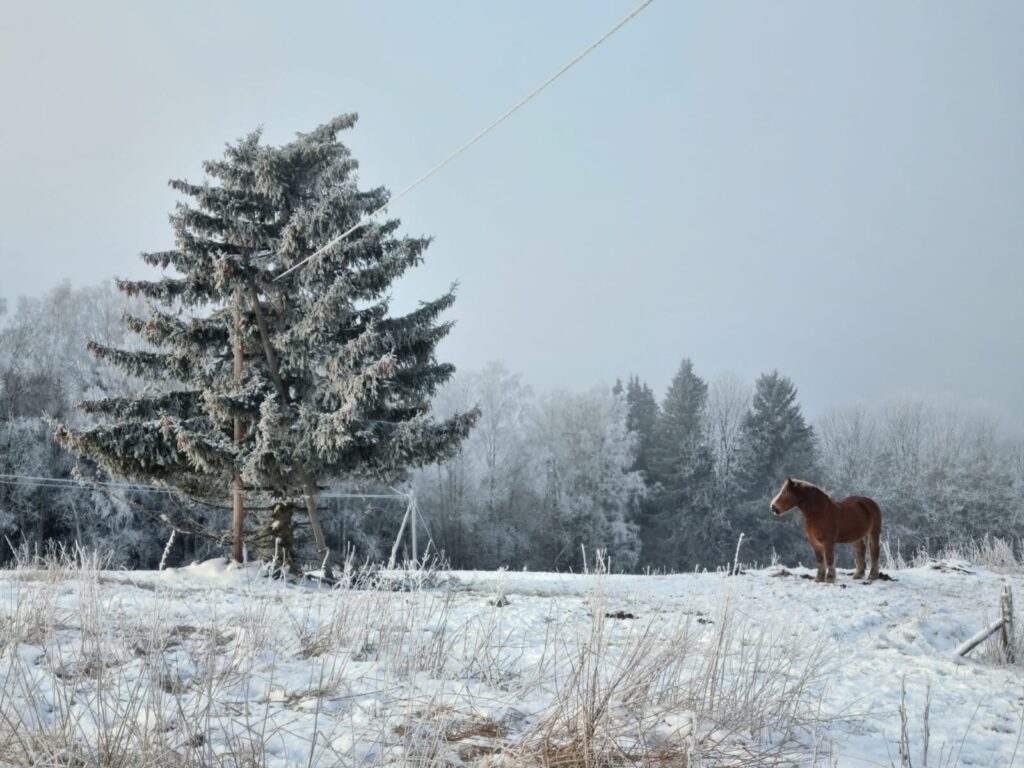
From a volunteer this year:
I stayed on Opsal Gård from October to December and had the most magical time there! We had many different tasks and I learned a lot: preparing vegetable beds for the winter, pruning raspberries and currants, taking care of the animals, building a chicken house, organizing a Christmas party and – one of my absolute highlights: we started a choir!
We started every morning with meditation, tasks were evenly split between every person and at the end of every week we did a check-in session where we talked about our experiences and feelings. The structure really helped me with the farm work and the working atmosphere. I could not have wished for a lovelier community!
Opsal Gård is also the perfect place if you fancy a good story from time to time. As a storyteller, Georgiana has a great repertoire of all kinds of stories from around the world that she would happily share, not only by the fireplace. And apart from being a great storyteller, Georgiana is also a wonderful host! I will remember her generosity, kindness, openness, wisdom, vulnerabilty, trust and interest in every person that stays on the farm.
I’m so grateful for every human and more-than-human being that has been a part of this journey. Opsal Gård will forever have a special place in my heart!
Rewilding, Beaver and other species
As a continuation of last year’s work with Tangen School, we have developed a beaver project. We want to inspire children and give them the chance to actually do something positive for biodiversity.
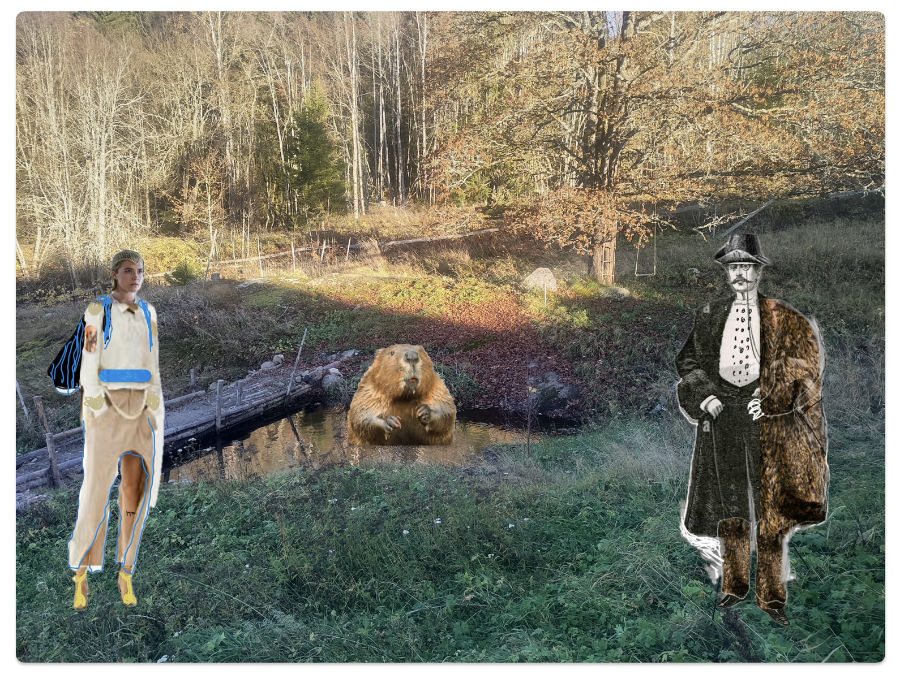
This will be a performance about beavers and then activities for schoolchildren. We have received support from the Bergesens Foundation and Innlandet to get started and have written the script.
We have also started to try out how to build a dam. On May 5th, we started to make small dams in the stream in the horse pasture.
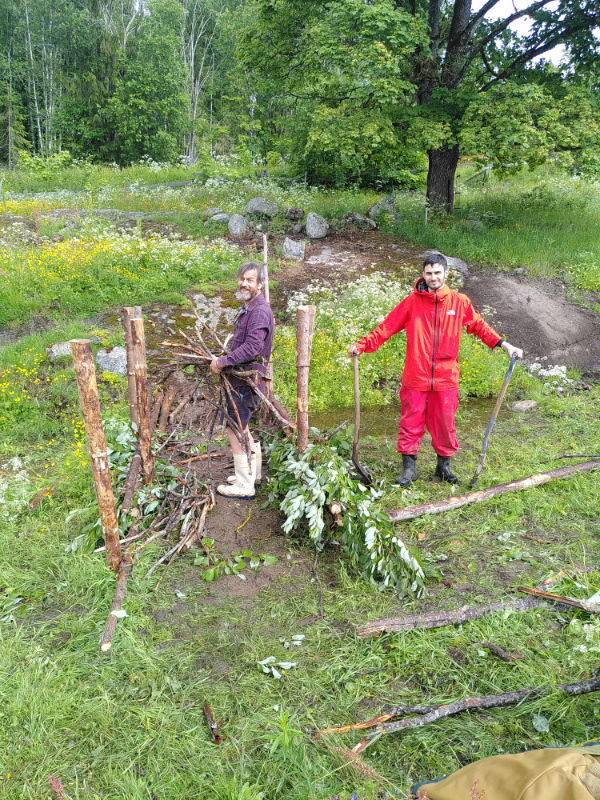
During the wedding we were visited by Prof Rowland Keable who immediately started building a dam and during the non-violence course with ‘People against fossil power’ we got good help to build dams on the south side of the farm.
We have planted seeds for wild flowers, tadpoles were found on 2nd May and shortly after the largest dam was built dragonflies were observed above the water. Small oak and walnut trees were planted in the east pasture.
There was a sighting of a lynx, and wildlife cameras showed hares. We have seen more animal tracks since the spruce was cleared from the east side. This year we heard the cuckoo for the first time. There are as many butterflies and bumblebees as before, and we had a visit from a professor of botany who found Scleranthus annuus (annual knawel) a rare plant.
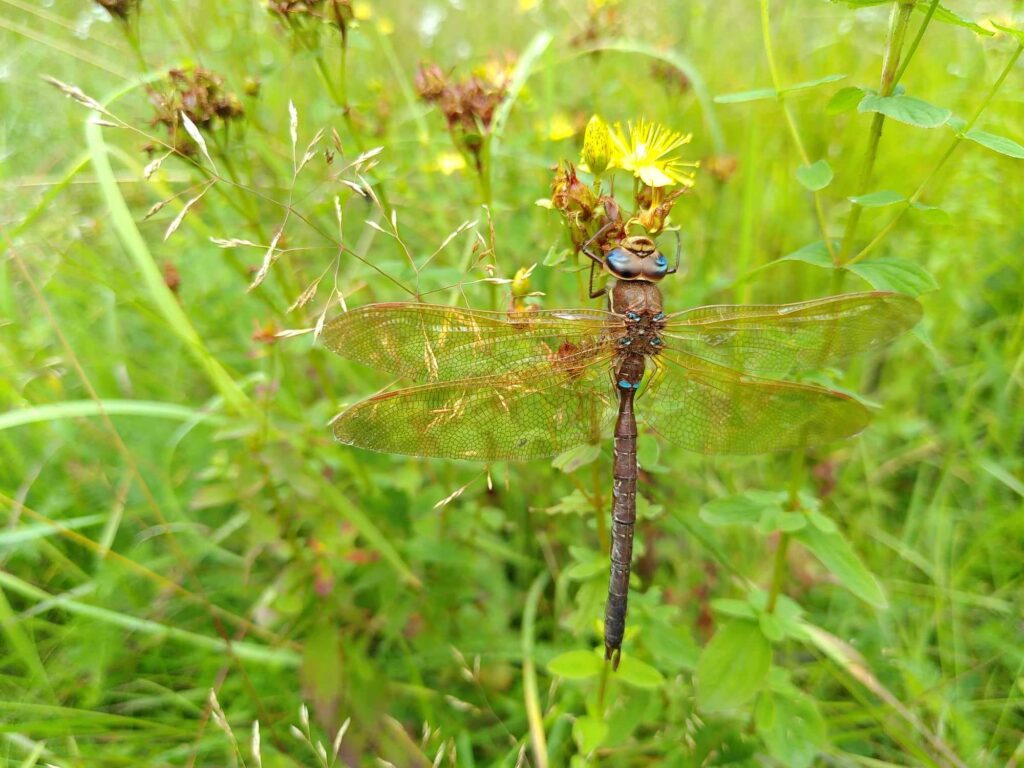
Social design and other initiatives on the farm
We had visits from 57 volunteers who stayed here over a period, most of them for over a month. There have been many exciting small collectives that have formed during the year.

Many initiatives have come from the volunteers – meals in different languages – Norwegian, French, English / multilingual, philosophical conversations, silent meals, poetry evenings, dance games, botanical walks and several visits to the Rotlia nature reserve, weekend visits to local huts, Mari’s tree walk in Oslo, concerts, etc.
But perhaps the most exciting thing was to form a choir with the help of our choir leader Joelle, 20 years old. It was very professional with voice exercises and her amazing piano accompaniment. We managed to sing with 4 harmonies and performed at the Christmas party to a warm appreciation.
Perhaps the most touching meeting was with a young man who had stayed in his room in France for over 4 years but then had dared to come out to Opsal farm. The warmth and care that he received from the others was fantastic and I think we all felt a sense of pride in everything he achieved. During a picnic he said: This is the best day of my life.
During 24/25, Helen Bøhler has developed a social design about the farm where we have been able to reflect on what is important. We hope this can be the basis for more people to become long-term residents on the farm. It has been an important process to go through and a help towards the goal of having other permanent residents and this year has seen our first two residents renting a room. See the link here: https://miro.com/app/board/uXjVNu2cy_M=/
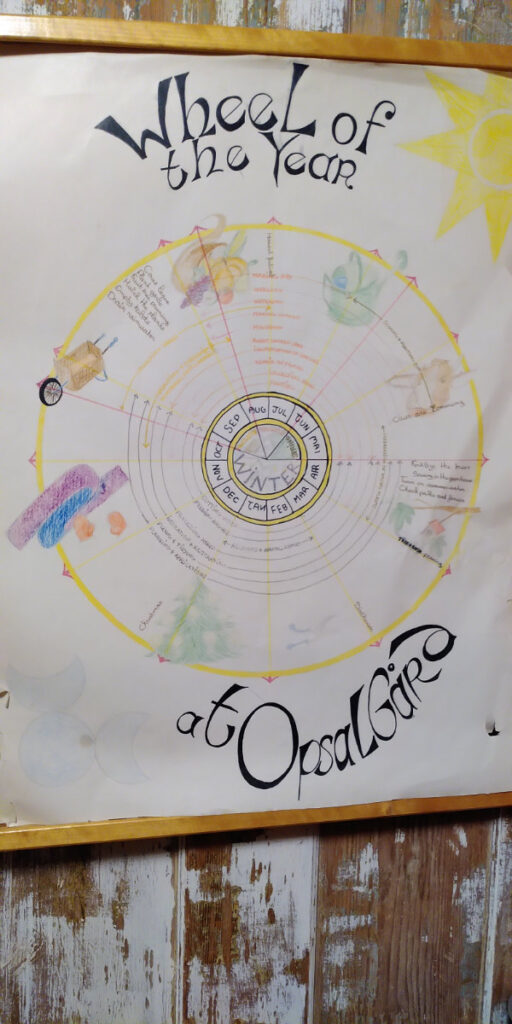
The vegetable garden
This year we have made a Polytunnel (10th April,), improvised with plastic and pipes. It was a significant improvement and meant seeds germinated several weeks earlier, but it was difficult to lift for irrigation. So we have a new design for 2025. The original vegetable beds with a 4-year rotation are becoming more productive, we have focused on peas instead of beans and it seems like it works better in the short season, but we’ll continue with broad beans.
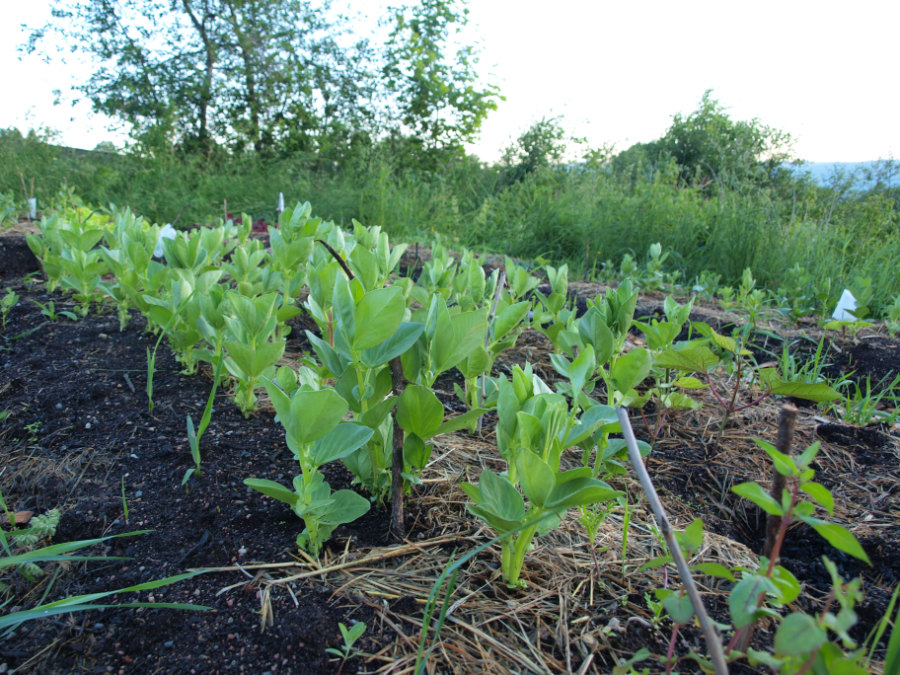
New flower beds and vegetable beds were made for squash which grew well. As in previous years, there was no rain between the snow melt and the end of May. So there was a lot of watering.
In August we were visited by Nenya, a Permaculture guru who had many good tips. She gave us a lot of good advice – including about the pond, the pigs, different plants, etc.
Fertilizer
We have used our own compost, though not well composted, and we have also used last year’s horse manure especially for the apple trees. Human manure that has been standing for 2 years was transported to swales on the other side of the farm where only trees will be grown. We have spent
more time working on composting this year, still not brilliant but improving year by year. We have also made liquid compost for irrigation.
We have again bought seeds from Solhatt but have some of our own seeds as well and our own seed potatoes.
Processing and storage

The last two winters we lost a large part of the potato harvest to frost. We discovered that behind the potato cellar there were two large holes and these were insulated with hay. We put juniper berries more carefully on the vegetables to prevent mice eating and stored the root vegetables in sawdust. So we still have root vegetables now in March!
This year we got better at drying different types of herbs. We collected meadowsweet, nettle, ladies bedstraw and many more and have made tea bags as gifts for volunteers who have been here and other guests.
We had a lot of apples again this year, but decided to make apple jam instead of apple juice. This has not been so successful, some have become mouldy, but we still have enough jam from berries so it is perhaps better to make apple juice like we did last year.
Construction projects – Barn
We received support – 70,000,- from Innlandet and 130,000,- from the Historical Monuments Association for the restoration of the barn.

We spent a lot of time moving timber that we have cut ourselves from spruce down the hill, the logs are large and heavy and often get stuck in the ice. It was transported down, moved to Holmen sawmill and sawn into planks for the barn floor. They had been sitting outside for over 2 years and were ready for use.
Manfred Augustin came and got advice from restoration expert Sveinung Sletten. The barn is huge and was sitting on crooked timbers. With the help of volunteers, he put tension bars to secure the log walls upwards and with the help of our dear neighbour and digger expert Erik Storhov we were able to put large stones under the walls. Then the floor was put in place well in time before the wedding. It remains to get the bottom sleepers in, restoration of the north west side and the roof.
The farmhouse
During the winter we have had wood fiber loft insulation blown in, for insulation value, damp possibilities and to protect the swallows who live there in the summer we considered this to be the best option. We have finished all the windows on the glass veranda, and thought of maybe using it as a partial greenhouse but it didn’t work that well. Maybe because we used old tomato seeds that were on the farm from 1971, which germinated but hardly bore any tomatoes!
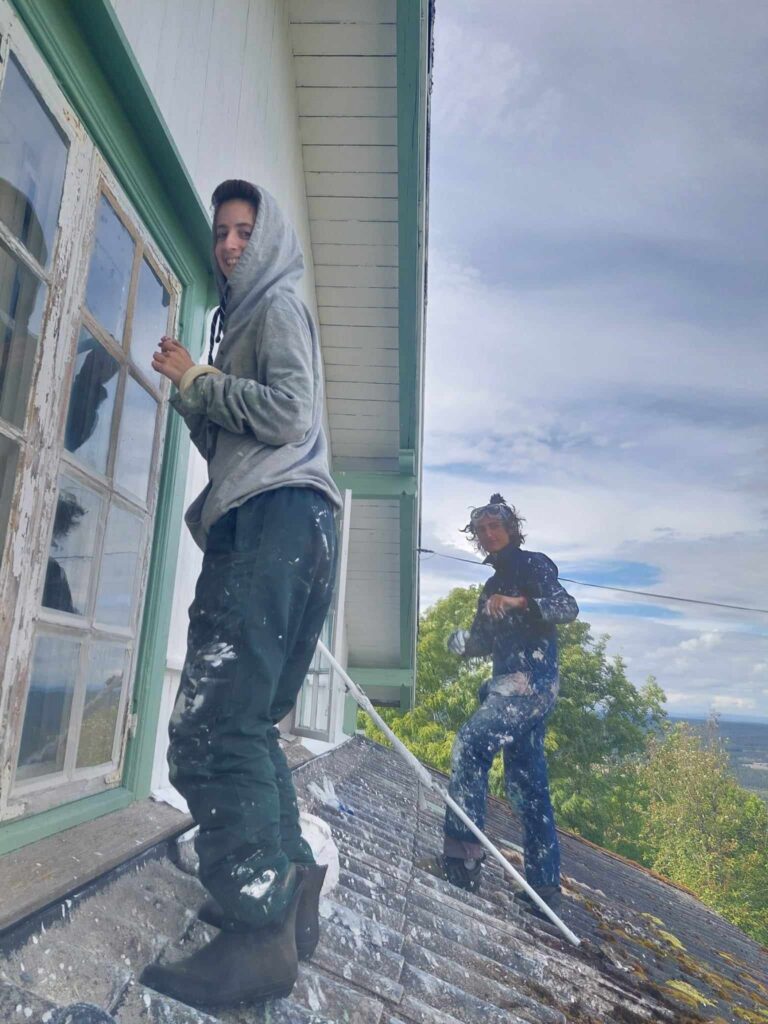
Exterior painting of the farmhouse was completed – after 3 years! Painting the north side of the house, we used so-called linseed oil paint from Jøtul. We have heard that it’s not a good product but having bought it we thought we would try it to compare how it works.
The remaining windows have been restored so now all the windows have been restored, only 3 exterior doors with windows are missing.
Outdoor shed building
The first building was set up by Zoe and three other French volunteers. They have never done anything like this before but were very enthusiastic and motivated. When they had left and we tried to set it up, we discovered that it was twice as high as it was wide! But when it was sawn down it works well as a bicycle shed.
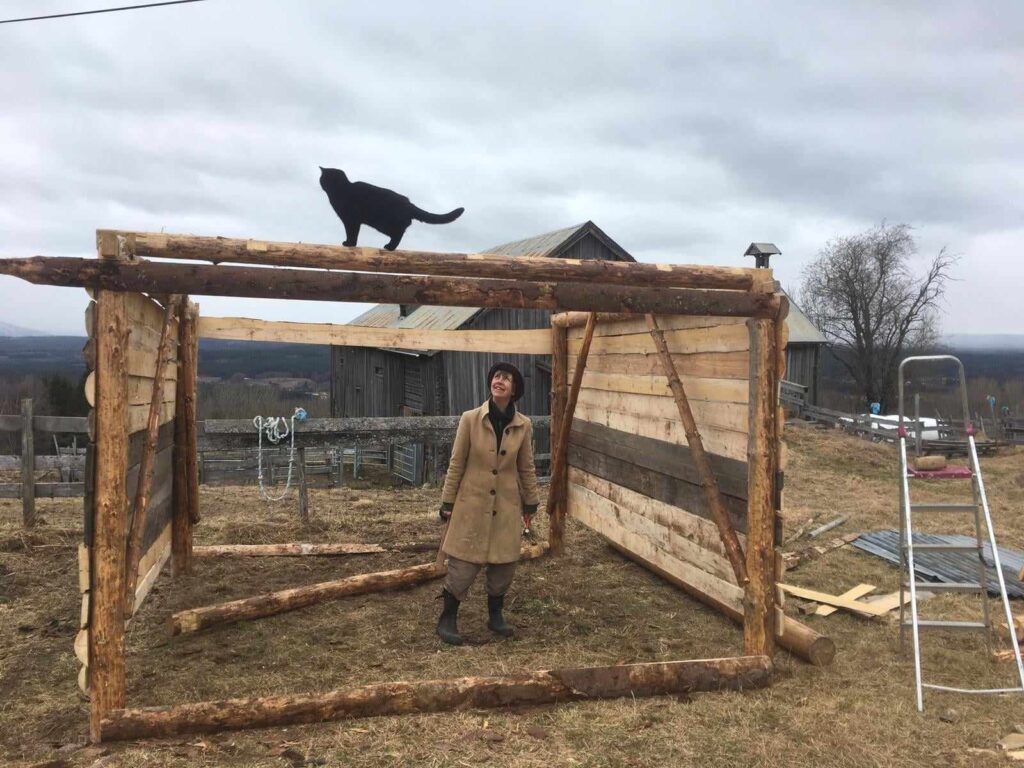
The second was set up in August by Francois and another fantastic team. They managed to create a more stable building for the horses. The new horse shed and the cycle shed were made with wood from spruce that we felled ourselves, some of the new planks and tin roof sheets that were stored here on the farm.
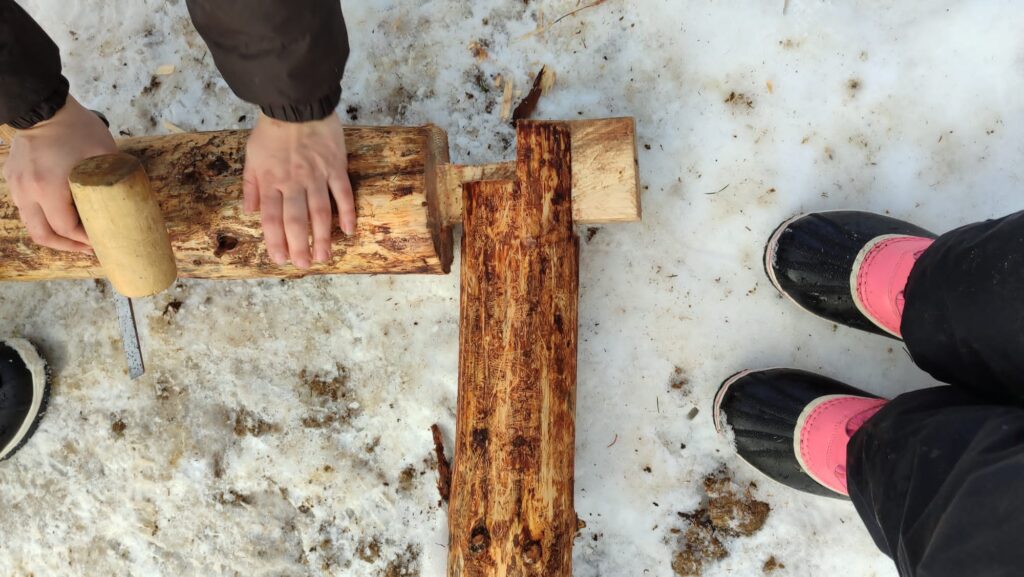
Forest and forest garden
Spruce clearing continues. The ‘More-than-human’ exercise, where all volunteers spend half an hour a week greeting a species that lives here continues. We made 8 new birdhouses and have seen all of them being used this year.
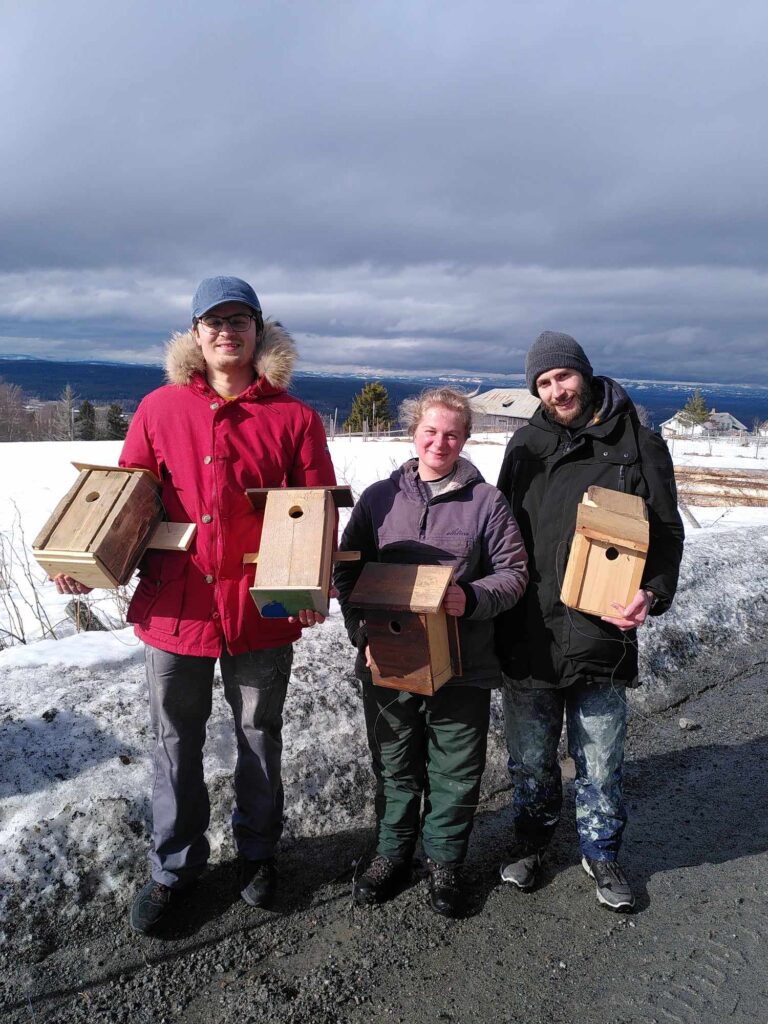
In the forest garden we had a volunteer who used a lawnmower to make a labyrinth. It was a lot of fun but it turned out that you had to mow the grass often to keep it in shape so it’s not something we’ll continue with next year.
Most of the saplings survived the extremely cold winter, thank goodness! We’ve tended them with compost and ash, but haven’t watered them much this year, thinking to encourage a stronger root system downwards in times of drought.
Building a chicken coop
We were lucky enough to have a young architect here for two months in the autumn and she had fun drawing and making chicken coops for us. We got the first Icelandic chickens just before Christmas.
The horses
In January 2024 Malva died at the age of 25. It was very sad but not surprising, she had been weak and sick for a long time.
Triton, a small Shetland pony, just a year old, came in February to keep Ciabatta company. They soon became inseparable!
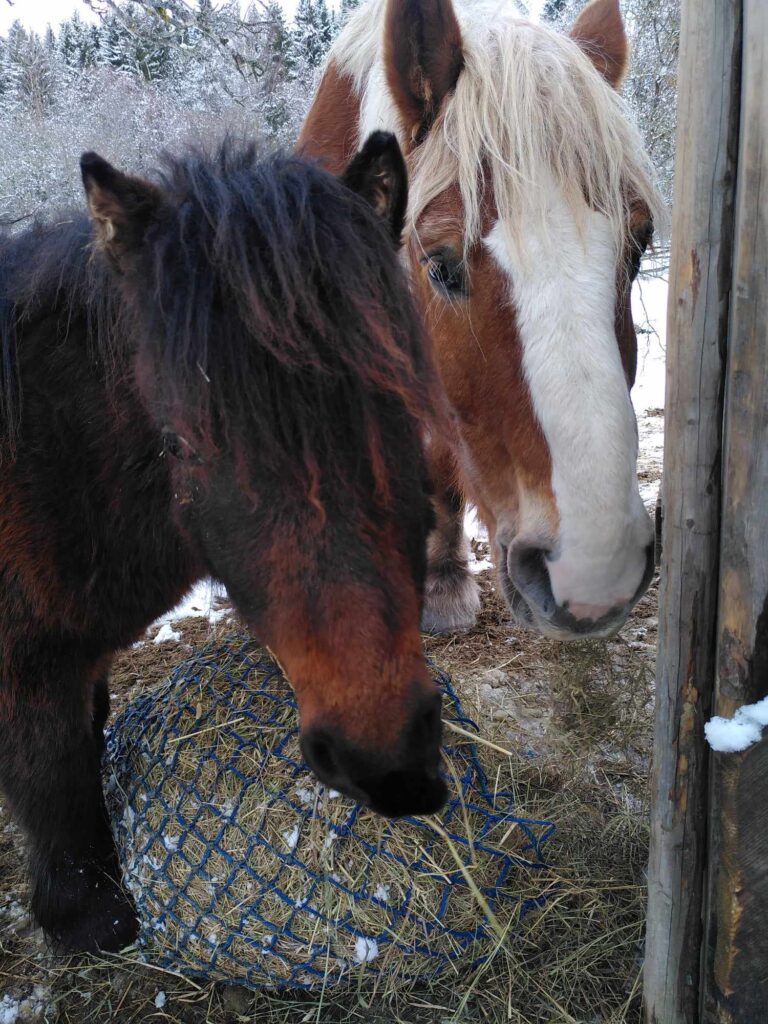
We moved Malva’s body down to the forest where it quickly disappeared. In the spring we renewed the electric fence in the horse field. We found a new farrier who is local and comes more reliably, it is expensive but important.
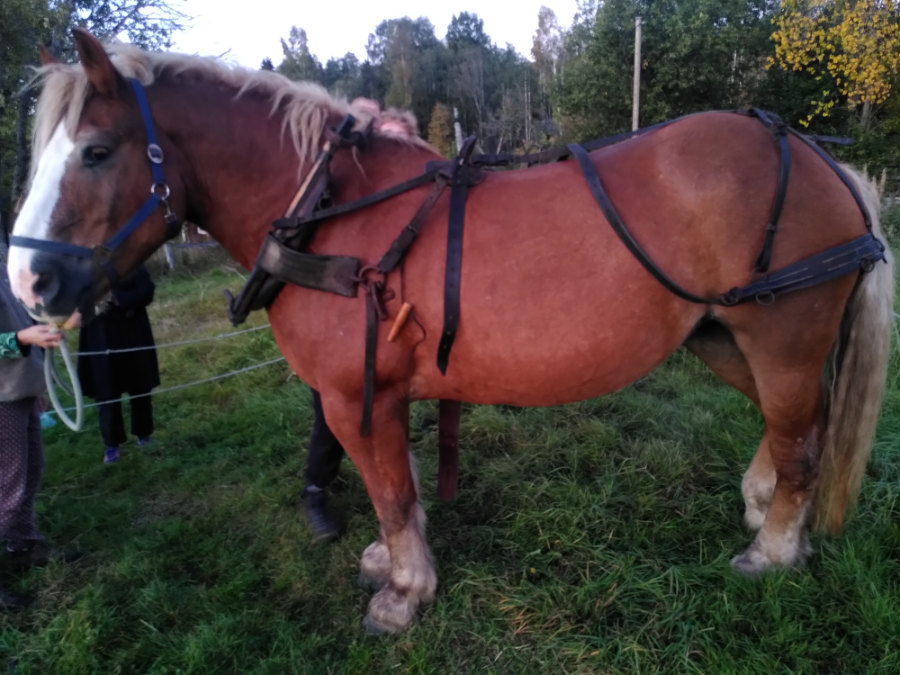
We have finally got some harnesses for Ciabatta and had a course with Luise from Fokhol farm to learn how to put them on and drive the horses. Geir and Lisa from the neighboring small farm have joined us on the course. So at last we have come one step closer to the goal of using her as a workhorse.
The horses only eat hay from our land. Drying the hay was difficult because of the rain every other day (it seemed) since May. Still, we managed to store quite a bit. Then Bjørnar Berge came with his tractor and put the hay in round bales, so we have more than enough for the winter. Next year maybe we will try to get a type of silo to avoid problems with drying.
Ciabatta had an eye infection that we have washed with chamomile, eyebright and calendula. It is washed twice a day, she accepted it and we started taking them over to the eastern pasture daily. She also became lame once, we don’t know why, it was after the farrier came, but we were given antibiotics by the vet.
We have spent a lot of time training especially when veterinary student Freya was here, we may not have gotten very far but we have kept good contact with the horses so that we are mostly good friends and they come when we call.
The pigs
We built a new pig fence in the eastern apple orchard. It has made a big change in the vegetation there and the plan is to expand the vegetable garden there in 2025.
During the year the pigs have not moved as much as last year. It takes a lot of work to build a fence that can keep them in. And since the original plan was to have them roam free, we took the decision to let them move on to the neighbor’s small farm. There they have a larger area, contact with the sheep and probably one of them will become a mother during 2025. It has been incredibly exciting to get to know them, they have been very tame but since we do not want to slaughter and its limited what they do for the rewilding project, we have decided to switch to chickens.
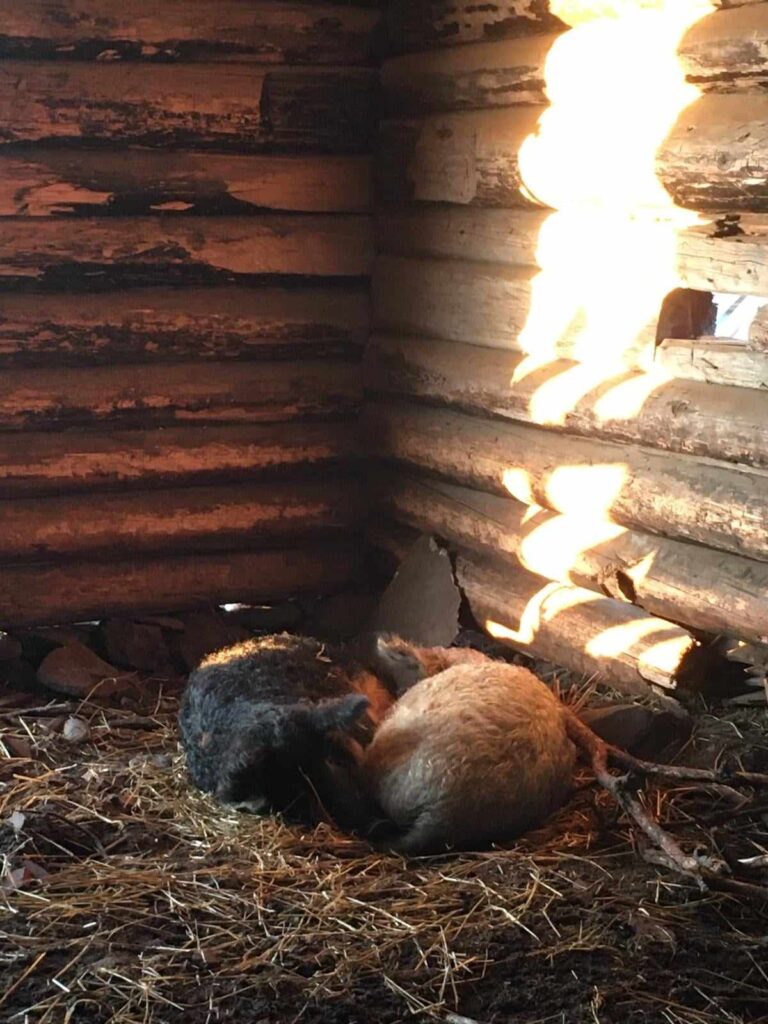
Wedding
Much of the spring was taken preparing the farm for the wedding of Ellen Jerstad, daughter of the farm and Ilker Dursun, they were married by Mari Jerstad from the Holistic Association.
It was important to get the barn ready so that it would be safe to have 150 guests, most of whom stayed overnight. The wedding ritual was consecrated at the ‘helicopter tree’ and celebrated in the house, yard, barn and outdoors.
The preparations for the wedding included extra outdoor toilet, extra mattresses, 3 extra tents, bar and DJ spot. The farm was transformed with small flags waving colorfully everywhere. We used the strong, stable scaffolding for the meal area at different heights. We moved trash and arranged new
trash containers, made signs, picked flowers and baked cakes. The children’s swing was repaired and a seesaw was made. An outdoor oven was constructed from old bricks for the lamb.
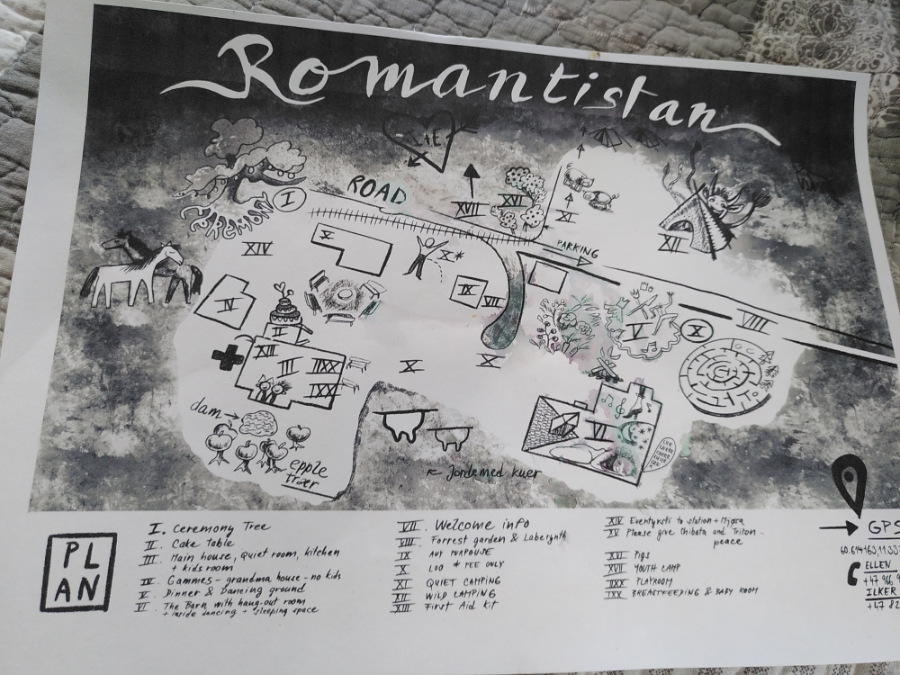
Here is the map of the wedding that lasted several days with 150 guests, music, dancing, food and joy. Thanks to Opsal farm!
Wind turbine industrial area
It was on the completely opposite end of the joy scale that we discovered that Stange and Romedal Allmenningen have plans to open for the construction of 240 meter high wind turbines near the farm. The fantastic nature in the large common forest will be seriously affected, it will cause major problems for many species locally, the local climate will be affected and much biodiversity will be destroyed for the future. Health problems for locals are likely from the noise pollution and housing values will decrease. Georgiana wrote an article in Stangeavisa and has become a board member of Motvind Stange.
Courses
Mari Jerstad held a plant walk in the Allmenningen, to identify plants to forage for food or medicinal use. There was a good turnout and it was great to get to know the nature and species in this area especially when it is under threat.
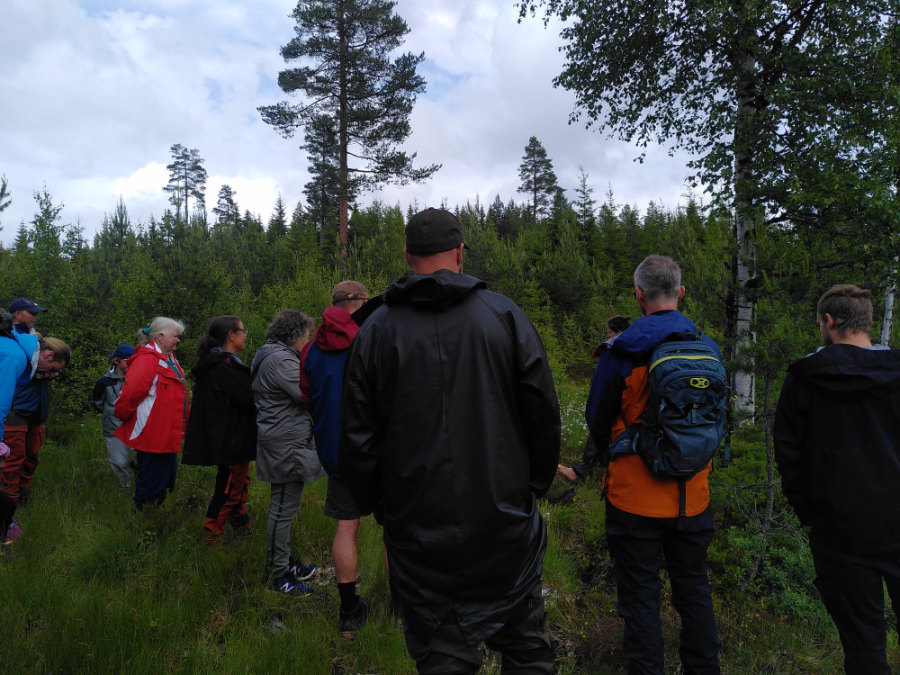
A non-violent action course was held by ‘People against fossil power’ with approx. 20 young participants. There were courses in non-violence, meditation, singing, conflict resolution, nature experience, etc.
Summer camp with Extinction Rebellion
Forget your perfect offering, there is a crack in everything – that lets the light get in.
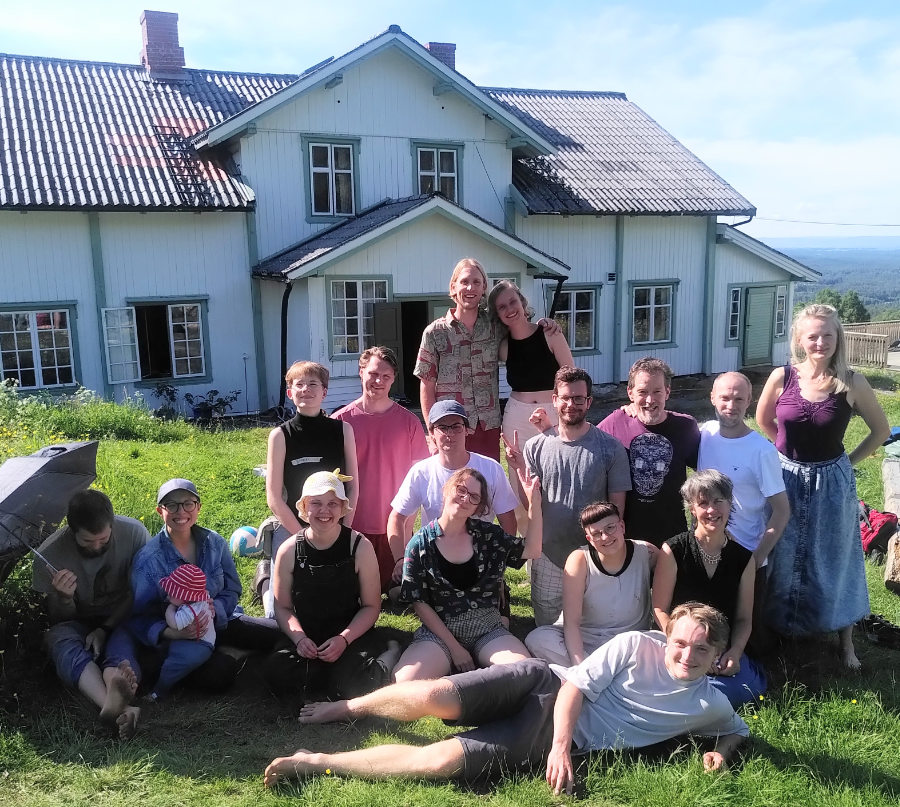
Approx. 30 participants took part in the various workshops ‘The work that reconnects’, kayak courses, conflict resolution etc. Yoga was held in the barn daily and we had exciting lectures from active members. We also worked on one of the dams so that it is almost finished except for clay lining.
Helgøya storytelling festival
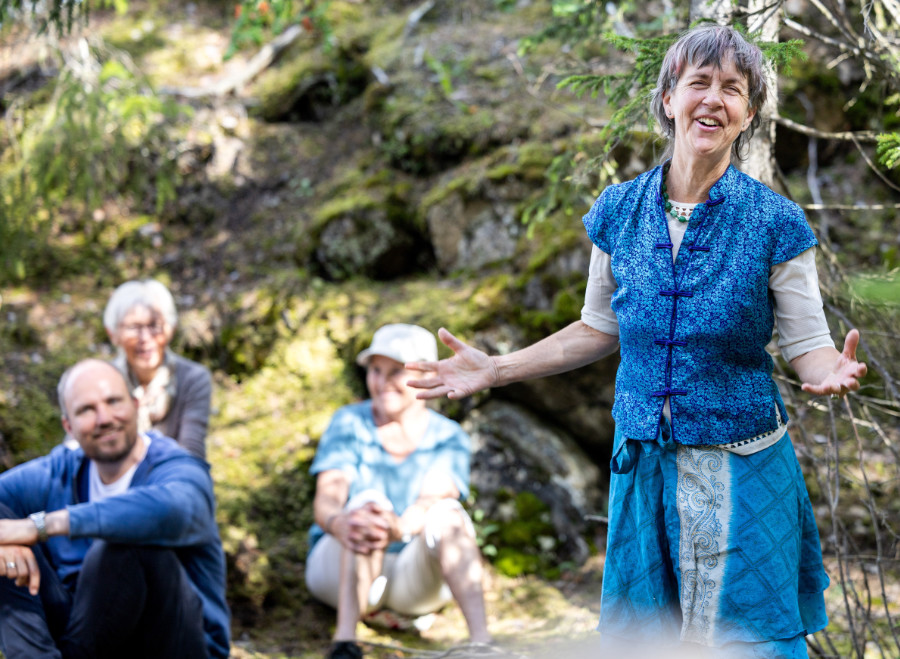
Georgiana, with two volunteers Ysee and Calliste joined the Helgøya storytelling festival, where Georgiana held a course in storytelling and forests. Ysee and Calliste participated in the course and became volunteers for the rest of the festival. Geo told at the opening and held a story walk in the nature reserve at the end.
Horse training course with Luise. For more on this, see above.
Contact with local people/neighbors
There is a desire to make more contacts locally. We have been to various concerts and events in the local area and celebrated May 1st and May 17th in Tangen. One of our closest neighbors often visits, helps us with transport and this year we drove her to the hospital and supported her with dog walks after she had hip surgery.
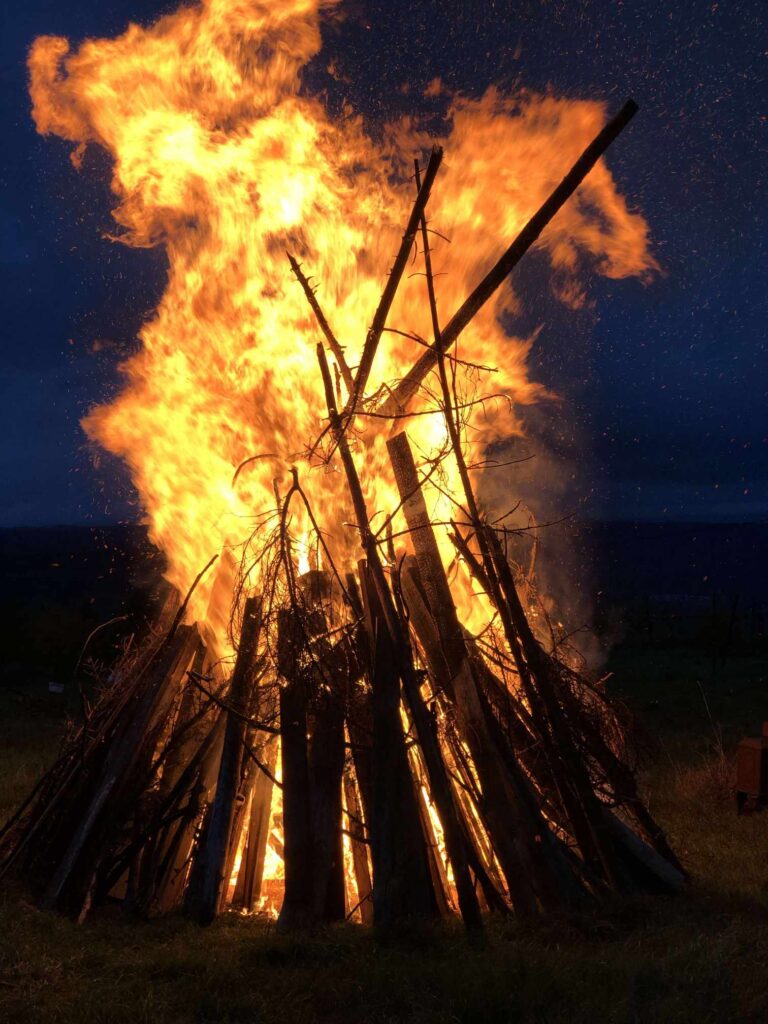
We have been active in ‘No to wind power in Stange Allmenning’ and were part of a nationwide bonfire action, one of 62 fires in Norway, local people joined here in September.
The farm’s 4th Christmas party was fantastic thanks to the lovely guests from near and far, and our choir performance after two months of practice. We have also had more contact with Fokhol farm thanks to horse harness training courses with Luise and with Geir and Lisa from the small farm below.
Other human encounters.
There have been some fantastic periods with incredible volunteers, Georgiana’s best friends from the UK, family, and a wedding that exceeded all expectations. There have also been many visits from the grandchildren, and thankfully the young volunteers join enthusiastically in the cooking, playing and singing that this involves.

There have also been too many people at times! From the autumn there have been fewer volunteers which was very relaxing, a chance to get to know people more in depth.
Finance and organization
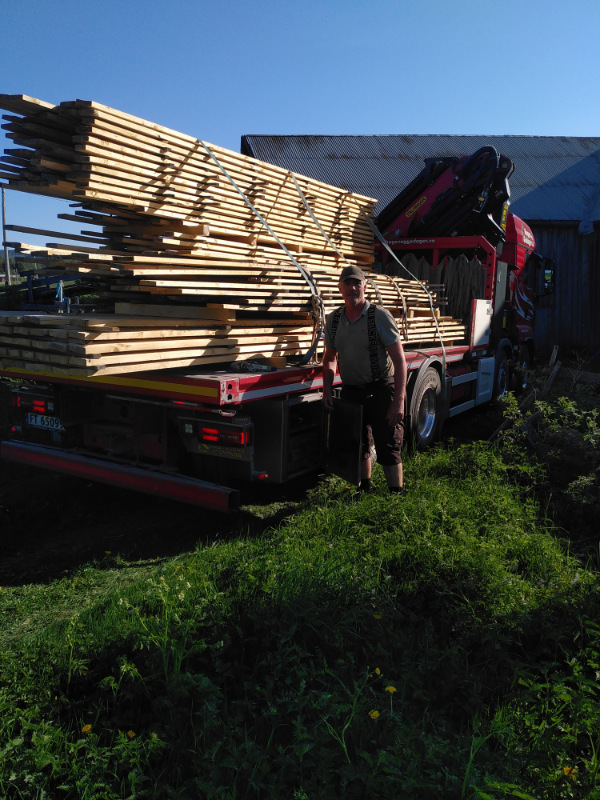
It was great not having to buy planks and to use the very local sawmill to transform spruce into the barn floor!
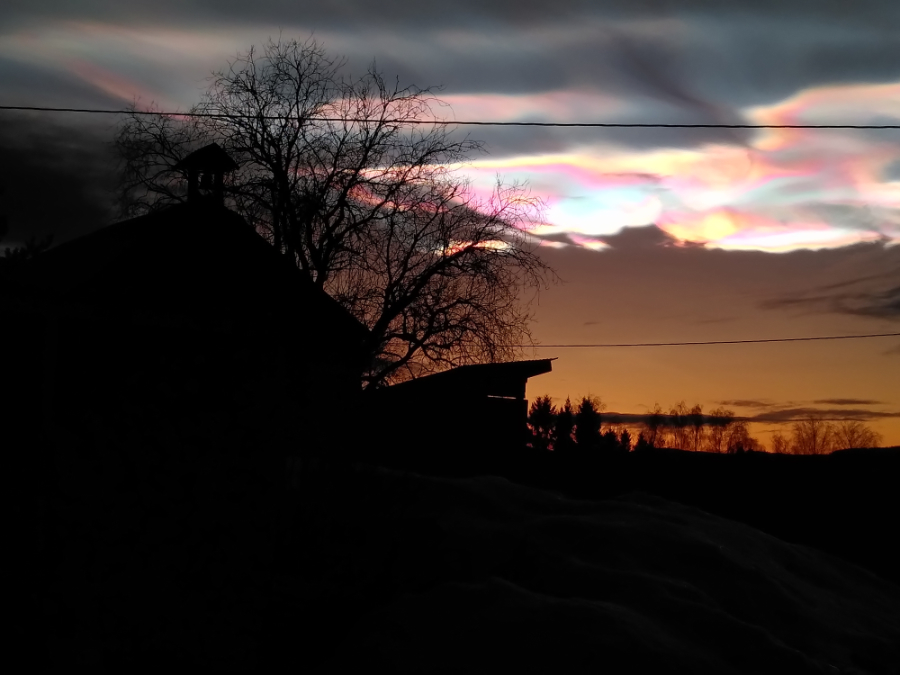
Georgiana has created a new organisation ‘Opsal Gård Jerstad’ so that it becomes clearer what are her personal expenses and property and what belongs to the Friends of Opsal Gård.
025